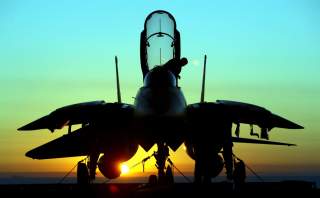That Short Time the F-14 Tomcat Was a Strike Aircraft
How exactly did that happen?
Key Point: The Navy was trying to find a purpose for the F-14 after the end of the Cold War.
The F-14 Tomcat was designed to defend the U.S. Navy’s fleets from practically every airborne threat. While it packed long range AIM-54 Phoenix missiles for defense against bombers carrying standoff missiles, it was no slouch in a dogfight either, although early versions were held back by its TF30 engines in that arena.
But for a brief period in the 1990s, the F-14 was used as a strike aircraft. The Navy’s retirement of the A-6 Intruders left a small capability gap until the new F/A-18E/F Super Hornets entered service, and the F-14 could carry more bombs than the new F/A-18A/C Hornet.
Operations in former Yugoslavia and the Gulf showed the need for a heavy strike aircraft in the Navy's arsenal. But how effective could the F-14 be in that role? While Israel used F-15B and Ds for ground strikes in relatively unmodified configurations, the U.S. Air Force spent a lot of effort developing a dedicated strike version of the F-15, the F-15E Strike Eagle. For the F-14, some small subsystems were installed, and the aircraft was sent on its way. Could it compete?
While the F-14 was only used operationally in the strike role by America in the 1990s, the aircraft was designed for it to a limited degree. Grumman showed the prototype carrying bombs, and flight tests were carried out with a rack of 14 Mark 82 bombs.
The F-14D, built with digital computers, expanded on this functionality: integrating more weapons onto the F-14. The F-14D was granted clearance by the Navy to drop bombs in 1992. However, it was the F-14B that would serve as the primary F-14 for ground attack.
The gap between the retirement of the A-6 Intruder in 1997 and the fielding of the F/A-18E/F Super Hornet in the 2000s let the Tomcat step up to the plate as a ground attacker. Anticipating the shortfall in capability, a Navy paper in December 1994 urged the acquisition of targeting pods so that Tomcat could fulfill this role.
Lockheed Martin’s LANTIRN pod was selected for this purpose, as it already was a mature system used by the Air Force. Integration was complete by 1996, mating F-14B airframes with the pod to make the “Bombcat.” The system saw its first operational use over Kosovo in 1999.
The Bombcats proved to be rather potent in usage. While some advanced functionality of the pod (e.g., navigation) was not integrated into the F-14, the images sent from the pod were more clearly seen. This was because pod sent its data to the radar intercept officer's Programmable Tactical Information Display System (PTIDS).
The PTIDS was a 20x20cm screen with rather high resolution, higher than the displays available in the F-15E. Thus, F-14 weapons officers found it easier to do precision lasing and guidance for bombs than their Air Force counterparts. The F-14 even buddy-lased designated targets with a laser for their fellow naval aviators flying F/A-18s due to the higher resolution and zoom of their LANTIRN pod.
During Operation Iraqi Freedom, F-14As equipped with the LANTIRN and PTIDS were some of the first aircraft in theatre. They covered and designated targets for Air Force F-15Es on Iraqi command and control bunkers. The Navy pilots later trained the F-15E crews to conduct the Forward Air Controller (Airborne)—FAC(A) mission.
That being said, the aging F-14A and B airframes had limitations that had to be worked around and limited their usefulness. F-14As couldn’t integrate with the newest JDAM bomb kits, and the F-14B wasn’t even cleared to use it, although it theoretically could.
The F-14D solved most of these issues and could integrate the high-resolution PTIDS, but the Tomcat’s lifespan was cut short in the mid-2000s when DoD cut funding for all Tomcat upgrades in favor of the new F/A-18E/F. Many have lamented this decision, as the Tomcat’s bigger airframe has advantages in the strike and interceptor role (650nm to the F/A-18E/F’s 475nm) as well as others.
In the words of one author, the F-14 was a Cold War plane the Navy didn’t really see a need to keep operating. The lighter Super Hornet provided much of the same capability while being much cheaper in fuel and maintenance costs. As a strike fighter, most of the F-14’s advantages were nullified by later upgrades to the F-15E Strike Eagle, which improved the avionics. The F-15E already possessed a greater bomb load and range, so the F-14D didn’t really provide any advantage there.
However, Iran still probably trains to use their F-14As in a strike role. Recent news suggests that the IRIAF is integrating new air-to-ground weapons on their Tomcat fleet. The “Bombcat” may have retired for the United States, but it soldiers on abroad.
Information was taken from Fighters over the Fleet: Naval Air Defense from Biplanes to the Cold War by Norman Friedman and Black Aces High: The Story of a Modern Fighter Squadron at War by Robert K. Wilcox.
Charlie Gao studied Political and Computer Science at Grinnell College and is a frequent commentator on defense and national security issues. This piece was originally featured in October 2018 and is being republished due to reader's interest.
Media: Reuters

